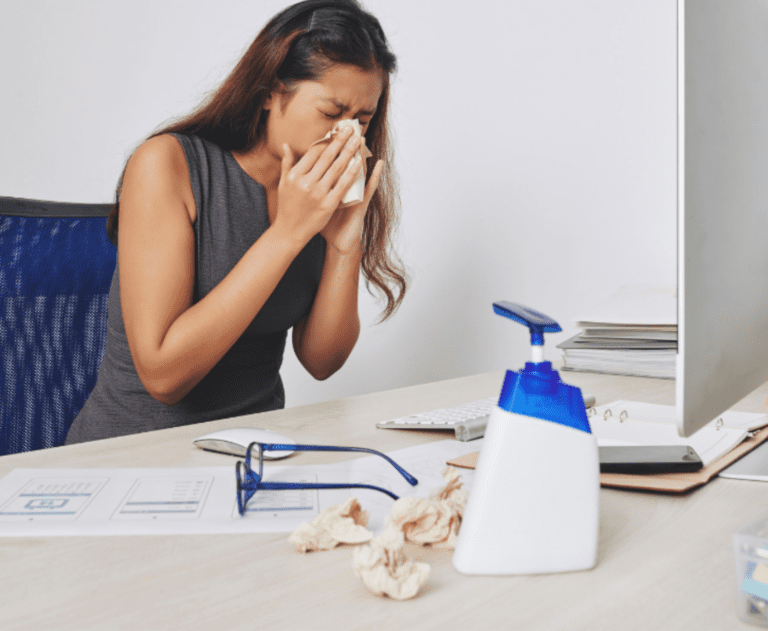Germs and viruses can spread faster than office gossip, and if workplace hygiene isn’t high on your priority list, then you’re more susceptible to all kinds of nasty bugs.
It’s estimated that, on any given day, five percent of the Australian workforce will call in sick, while others will continue to come to work and ‘soldier on’. According to Safe Work Australia, the flu season can lead to significant absenteeism, costing businesses millions in lost productivity.
In Australia, the flu season typically peaks between June and September. The Australian Institute of Health and Welfare (AIHW) reports that influenza causes approximately 18,000 hospitalisations annually. In 2023, the Department of Health and Aged Care noted a significant rise in flu cases compared to previous years, emphasising the need for effective workplace health strategies.
A study conducted by the University of Arizona placed a virus on just one commonly-touched surface (such as a door knob or bench top) within an organisation. Throughout the day, researchers checked a variety of other surfaces throughout the entire institution. They found that within two to four hours, the virus had spread to almost 60% of surfaces.
Modern office set-ups that feature hot-desks only amplify this rapid spread. When shared surfaces are not cleaned efficiently, illness can spread easily. A highly-contagious illness could decimate productivity for a small to medium business and bring any large department to a standstill.
It’s not only employee wellbeing and productivity that should motivate your need to clean. The simple fact is that when it comes to your office space, appearance matters. A clean and fresh office will leave a positive and lasting impression on the people within it. On the flip side, a drab, cluttered and dirty office will also leave an impression – but probably not the one you want.
Effective measures to keep your workplace healthy:
1. Promote Vaccination
Encouraging flu vaccinations is a highly effective strategy to prevent the spread of influenza in the workplace. According to the National Centre for Immunisation Research and Surveillance (NCIRS), flu vaccines can reduce the risk of flu-related hospitalisations by approximately 40-60%.
- On-site Vaccination Clinics: Collaborate with healthcare providers to offer on-site flu vaccinations for employees.
- Incentivise Participation: Offer incentives such as extra leave days or small bonuses to employees who receive the flu vaccine.
2. Encourage Sick Employees to Stay Home
One of the main drivers of illness spread in the workplace is presenteeism—when employees come to work despite being sick. According to the University of Wollongong, presenteeism can cost Australian businesses up to $34 billion annually.
- Flexible Sick Leave Policies: Develop and implement flexible sick leave policies that enable employees to stay home without worrying about financial loss or job security.
- Remote Work Options: Promote the option for employees to work from home if they are unwell but still capable of performing their duties.
3. Promote Good Hygiene Practices
Encouraging employees to practice good hygiene is the first line of defense against illness. According to the Australian National University, proper handwashing can reduce the incidence of respiratory infections by 16-21 percent.
- Handwashing: Ensure employees wash their hands with soap and water for at least 20 seconds, especially after using the restroom, before eating, and after coughing or sneezing.
- Hand Sanitisers: Provide alcohol-based hand sanitisers (containing at least 75% alcohol) in common areas and at workstations.
4. Regular Cleaning and Disinfection
Maintaining a clean office environment helps minimise the spread of germs and illnesses. The Australian Government Department of Health advises regular cleaning and disinfection of frequently touched surfaces like door handles, keyboards, and phones.
- Daily Cleaning: Establish daily cleaning routines for high-traffic areas and shared equipment.
- Professional Services: Engage professional cleaning services for comprehensive weekly or bi-weekly deep cleans.
5. Improve Indoor Air Quality
Good ventilation helps lower the concentration of airborne pathogens. The Australian Institute of Refrigeration, Air Conditioning and Heating (AIRAH) highlights the significance of maintaining proper air quality indoors to reduce the spread of illnesses.
- HVAC Systems: Ensure that heating, ventilation, and air conditioning (HVAC) systems are well-maintained and functioning efficiently.
- Air Purifiers: Use air purifiers with HEPA filters in areas where ventilation is poor.
6. Foster a Supportive Culture
Creating a supportive workplace culture where employees feel comfortable reporting illness and taking necessary precautions is essential for maintaining a healthy and productive environment.
- Lead by Example: Ensure that management visibly adheres to health protocols, such as staying home when they are sick. This sets a strong example for employees, showing that their health is prioritised.
- Promote Health Initiatives: Implement and actively promote workplace health initiatives. This can include flu vaccination drives, wellness programs, and providing resources for mental health support.
- Transparent Policies: Clearly communicate health and safety policies to all employees. Make sure these policies are easily accessible and regularly updated.
- Encourage Feedback: Create an open environment where employees feel comfortable providing feedback on health and safety practices. This can be facilitated through regular surveys, suggestion boxes, or dedicated meetings.
- Health and Safety Training: Offer regular training sessions to educate employees about illness prevention, recognising symptoms, and the importance of taking sick leave when needed.
Tips for Optimal Office Cleanliness:
- Choose the appropriate product for the job, as one product will not suit all surfaces. For instance, an abrasive cleaner applied to a high-sheen surface might permanently damage it. Choose a cleaning product specifically designed for your flooring, windows, doors, tables and benchtops.
- When buying office cleaning products, cost is not the only factor. A small investment in the correct cleaning products might save you a lot in time, money and productivity in the long run.
- Where possible, look for eco-friendly cleaning products. There are many products available that are less harmful to the environment, but still tough on dirt and germs.
- Invest in quality cleaning equipment that will last.
- Re-stock cleaning supplies regularly to ensure your cleaning schedule is maintained.
- Ensure everyone knows where the cleaning products and equipment are kept. If there is a spill throughout the work day, don’t leave it for the cleaners to attend to at the end of the day. Spills should be cleaned immediately to remove any potential slip or trip hazard.
- Make sure your business has enough safety signs to communicate any trip or slip hazards.
- If your office uses hot-desks, ensure every desk has cleaning wipes and hand sanitiser available, and signage to encourage its correct use.
- Remind staff that hygiene measures such as handwashing with soap, catching sneezes and coughs in a tissue (and disposing of it immediately), or staying home when unwell are all important ways to prevent the spread of germs.
A clean and tidy work environment encourages productivity and job satisfaction, while decreasing the likelihood of workplace illness or injury. Simple steps like displaying signage to remind staff of hygiene standards will help to reduce the spread of germs and keep everyone healthy and happy.

